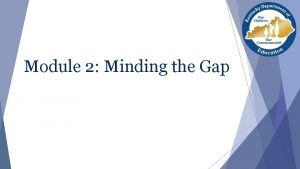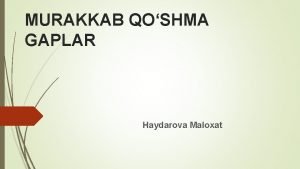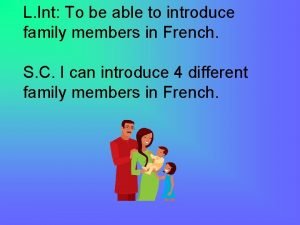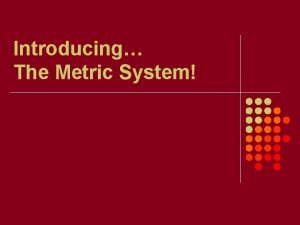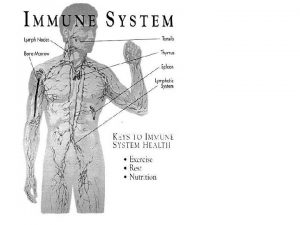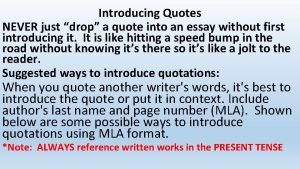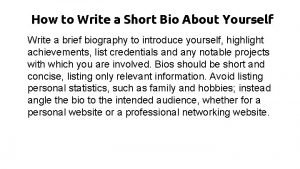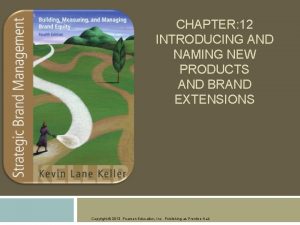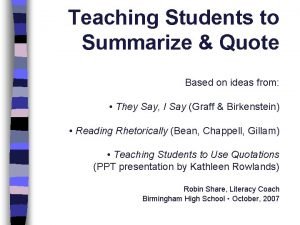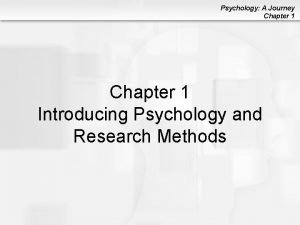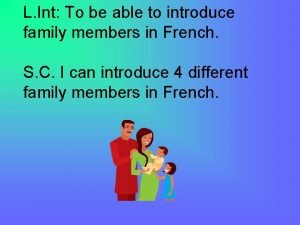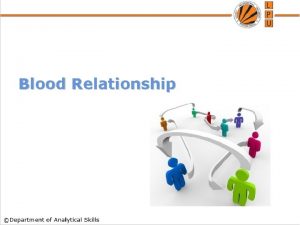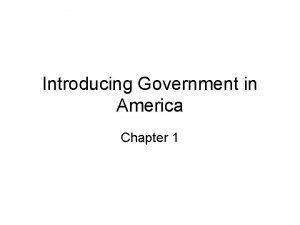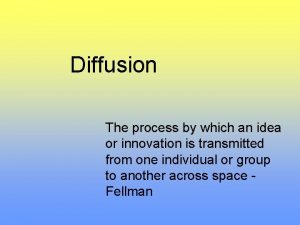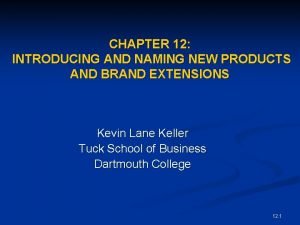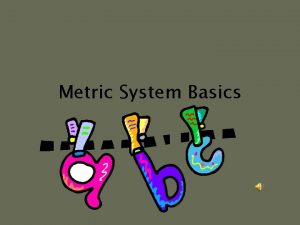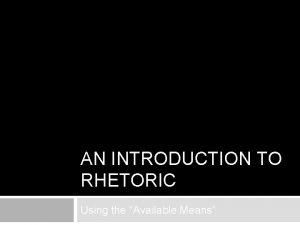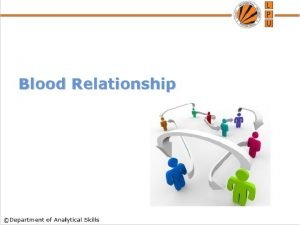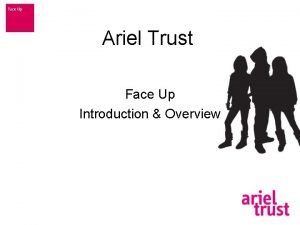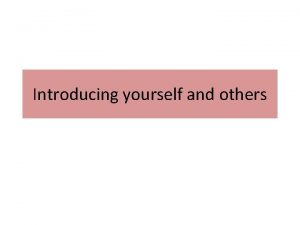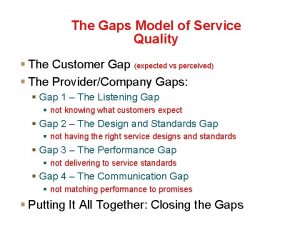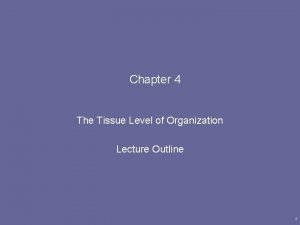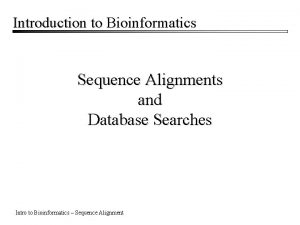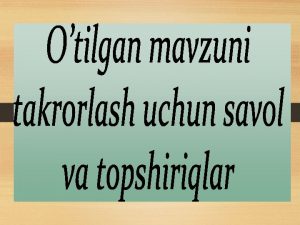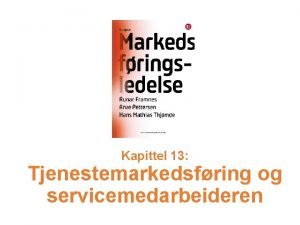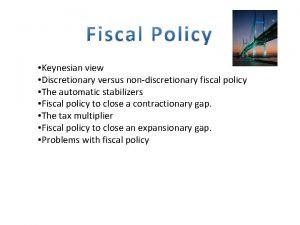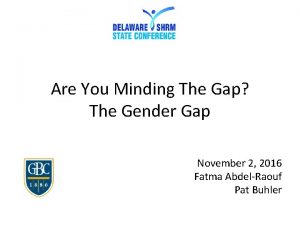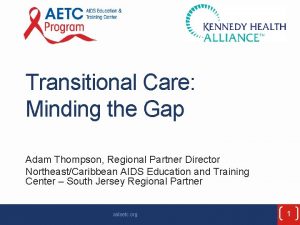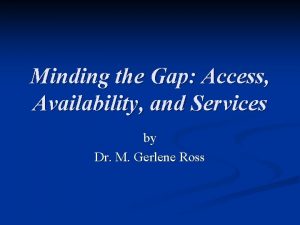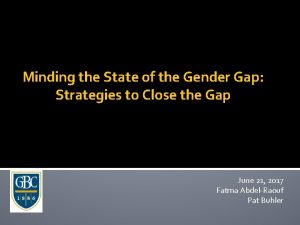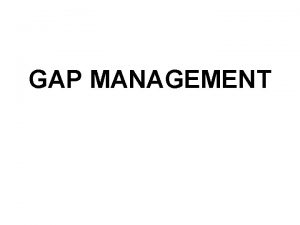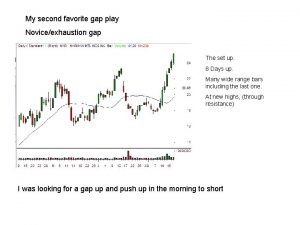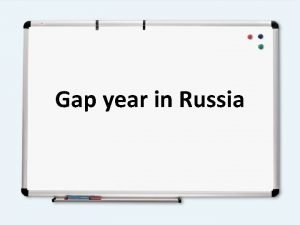Module 2 Minding the Gap Introducing Module 2
































































































- Slides: 96

Module 2: Minding the Gap

Introducing Module 2 Minding the Gap 2

Module 2 Goals Build a shared understanding of the KAS for Social Studies progressions and grade-level expectations. Begin to map the expectations of the KAS for Social Studies to current practice and curricula. Identify gaps and overlaps between the KAS for Social Studies and current practice and curricula. Identify and prioritize gaps that exist, and consider available curriculum resources, time allocation for each content area, and any additional solutions to eliminate gaps. Create a proposed plan of action to successfully implement the 2019 KAS for Social Studies and close gaps. 3

The Work of Module 2 The processes and subsequent work outlined in Module 2 is the “bulk” of the standards implementation work. While time has been recommended for each part of the Module, the work of analyzing the standards, identifying the gaps and redundancies, and generating an implementation plan should be ongoing and consistently revisited. 4

Minding the Gap – Essential Questions Why are there progressions of learning in the KAS for Social Studies ? How do we ensure all students have consistent access to the content and skills required in the KAS for Social Studies ? 5

Overview of Module 2 6

Why Is This Work Important? Engaging in this work allows teachers to consider the types of learning experiences, or significant learning “events, ” designed to build student mastery of the standards. They represent the intended student learning, not the activities in which they will engage. Some educators think that the standards, since they are arranged in a list, need to be covered one by one in lessons and units. This practice is not the intent or purpose of standards. The standards are meant to be taught in an integrated/interrelated way; multiple standards can and should be taught at the same time. If the transfer of concepts and meaning making are important goals of an education, those goals will not be achieved by simply marching through discrete content and concepts. 7

Warm-Up 1. Skim your K-8 grade or high school standards. How well do you think your current scope and sequence, curriculum, materials, and teaching practice align to the revised standards? 2. What might need to be done to address any gaps in the curriculum? 3. What are some of your biggest questions regarding implementation of the standards? 8

Coming Up Module 2 a: Understandin g Progressions Module 2 e: Bridging the Gaps Module 2 d: Identifying Gaps and Overlaps in the Standards Module 2 b: Unpacking the Standards Module 2 c: Mapping the Standards to Current Practice 9

Reflection Now that you have completed the introduction to Module 2. . . 1. What are your expectations for the next 5 modules? 2. What questions might you have regarding the steps in the minding-the-gap process? 10

Module 2: Minding the Gap 2 a: Understanding Progressions 11

Group Norms Assume best intentions. Listen carefully to one another. Be open to new ideas. Be open to working outside your comfort zone. Ask questions. Allow a chance for everyone to participate. 12

Module 2 Goals Build a shared understanding of the KAS for Social Studies progressions and grade-level expectations. Begin to map the expectations of the KAS for Social Studies to current practice and curricula. Identify gaps and overlaps between the KAS for Social Studies and current practice and curricula. Identify and prioritize gaps that exist, and consider available curriculum resources, time allocation for each content area, and any additional solutions to eliminate gaps. Create a proposed plan of action to successfully implement the 2019 KAS for Social Studies and close gaps. 13

Minding the Gap – Essential Questions Why are there progressions of learning in the KAS for Social Studies ? How do we ensure all students have consistent access to the content and skills required in the KAS for Social Studies ? 14

Warm-Up Finish this sentence … A learning progression is like ________ because ____________. 15

Module 2 a: Understandin g Progressions Module 2 e: Bridging the Gaps Module 2 d: Identifying Gaps and Overlaps in the Standards Module 2 b: Unpacking the Standards Module 2 c: Mapping the Standards to Current Practice 16

What Are Learning Progressions? Learning progressions that clearly articulate a progression of learning in a domain can provide the big picture of what is to be learned, support instructional planning, and act as a touchstone formative assessment. -Margret Heritage 17

What Are Learning Progressions? “reasonably coherent networks of ideas and practices … that contribute to building a more mature understanding. … The important precursor ideas may not look like the later ideas, yet crucially contribute to their construction. ” (Duschl et al. , 2007) 18

What Is a Learning Progression? “Descriptions of the successively more sophisticated ways of thinking about an idea that follow one another as students learn” (Wilson & Bertenthal, 2005) “A picture of the path students typically follow as they learn. . A description of skills, understandings, and knowledge in the sequence in which they typically develop”(Masters & Forster, 1996) 19

Brainstorm the Core Concepts in Social Studies 20

Organize the Concepts Clipart source: Microsoft 21

Kentucky Learning Progressions Clipart source: Microsoft 22

Key Components of the Standards Disciplinary Strands Inquiry Practices Disciplinary Concepts and Practices Standards 23

Guiding Principles Based on (and refined by) available research and promising practices. The key components are the “essence” of social studies, and are the binding threads that connect the disciplines. May not be linear, but articulate movement toward increased understanding (e. g. , deeper, broader; ability to apply, generalize, or transfer; more sophisticated) — not just harder! 24

Kentucky Academic Standards for Social Studies Organized in progressions from K through 12 by grade level, inquiry practice, discipline and concepts and practices 25

Disciplinary Strands The disciplinary strands identified in the KAS for Social Studies are civics, economics, geography and history. In Kentucky, the discipline strands in social studies are meant to be taught in unison. Students recall and understand themes and topics better if the social studies strands are integrated and not taught in isolation. 26

Inquiry Practices 27

Concepts and Practices Within the discipline strands, students engage with disciplinary concepts and practices outlined in the chart on pages 16– 20 in the KAS for Social Studies. • Disciplinary concepts are the broad ideas that enable a student to understand the language of each discipline and are designed to remain with students long after they are transition ready. • The disciplinary practices are the skills students are expected to learn and apply when engaging with the disciplinary concepts. • The concepts remain the same throughout the document, and only appear when they are grade-level, theme and discipline appropriate. 28

Concepts and Practices Traditionally, Kentucky studies was the focus of fourth grade. However, the KAS for Social Studies requires a disciplinary study of Kentucky throughout a child’s social studies education in K through 12. Consider: 1. What are the advantages of studying Kentucky throughout the K– 12 progression? 2. How does a more sophisticated understanding of Kentucky allow a student to better understand self, others, and the world? 29

K– 12 Progressions Reflection 1. How do the K– 8 themes support learning progressions? 2. How do the inquiry practices, discipline strands and disciplinary concepts and practices support learning progressions? 3. How might the progressions be useful for vertical alignment? In PLCs? 4. Where might you need additional support? 30

Discovery Task If you are a K– 8 teacher, review Looking Back, Looking Ahead. Individually, with a partner or in a small grade-banded group, analyze how this section can help a teacher begin to see the progressions from one grade to the next. If you are a high school teacher, review the K– 12 progressions starting on page 155 of the standards document. Individually or with a small team, analyze how these progressions impact and support learning in your grade or course. 31

Stop here if you are only completing Module 2 a: Reviewing Progressions. If you would like to complete another section of Module 2 at this time, continue onto the next slide to begin facilitating Module 2 b: Analyzing the Standards. The KDE needs your feedback on the effectiveness of this module. Please consider completing this Professional Learning survey. 32

Coming Up Module 2 a: Understandin g Progressions Module 2 e: Bridging the Gaps Module 2 d: Identifying Gaps and Overlaps in the Standards Module 2 b: Unpacking the Standards Module 2 c: Mapping the Standards to Current Practice 33

Module 2: Minding the Gap 2 b: Unpacking the Standards 34

Group Norms Assume best intentions. Listen carefully to one another. Be open to new ideas. Be open to working outside your comfort zone. Ask questions. Allow a chance for everyone to participate. 35

Module 2 Goals Build a shared understanding of the KAS for Social Studies progressions and grade-level expectations. Begin to map the expectations of the KAS for Social Studies to current practice and curricula. Identify gaps and overlaps between the KAS for Social Studies and current practice and curricula. Identify and prioritize gaps that exist, and consider available curriculum resources, time allocation for each content area, and any additional solutions to eliminate gaps. Create a proposed plan of action to successfully implement the 2019 KAS for Social Studies and close gaps. 36

Minding the Gap – Essential Questions Why are there progressions of learning in the KAS for Social Studies ? How do we ensure all students have consistent access to the content and skills required in the KAS for Social Studies ? 37

Warm-Up What does it mean to “unpack” standards? Brainstorm reasons to “unpack” standards. 38

What Are Standards? Standards define what students should know, understand be able to do at the end of a grade level. Definition Know Refers to facts, dates, places, people, definitions, rules, or information Understand Refers to theories, generalizations, or “big ideas” Do Refers to skills such as communication, reading, computation, application, and transfer to new situations 39

Why Unpack a Standard? Enhances student understanding and mastery Enables teachers to interpret standards the same way Provides teachers with a common roadmap for developing unit and lesson plans 40

What Does It Mean to Unpack a Standard? Breaking a standard into smaller, more explicit chunks for the purposes of curriculum development and/or unit and lesson planning. For example, analyze the verb in the following standard to determine its meaning in terms of instruction and assessment. 1. “. . . understand the development of important community traditions and events. ” What does understand mean in this standard? Does it mean “make meaning of” or “transfer”? Does it mean to “accurately state and explain”? Or, does it simply mean to “know”? What does the verb demand in terms of student learning? 41

When Unpacking a Standard, Ask a Series of Questions: What knowledge will students need to demonstrate the intended learning? What understandings will they need to master? What skills will they need to apply to demonstrate mastery? How might students demonstrate the requisite skills through learning experiences? 42

Doing It Together Breaking down the standards allows for collegial conversations that should result in a common agreement on the learning expectations. 1. Define the language of the standard 2. Determine the level of rigor indicated, in part, through the verb used and the grade level of the standard 3. Analyze and translate to better incorporate into curriculum, unit, and lesson plans 4. Analysis is essential at the local level if the standards are to be validly and consistently taught among teachers 43

Tool to Unpack Standards Step 1 Step 2 Step 4 Unpacking the Standard What Knowledge/Concepts/ What skills do students need What level of proficiency do Vocabulary do students need to know to reach this to be able to do to reach this students need to be at in standard? order to reach this standard? Step 3 44

Step 1: List the Standards for Your Grade/Course Cut and paste the standards, including the inquiry practices, into the furthest left column of the spreadsheet Unpacking the Standard What Knowledge/Concepts/ What skills do students need What level of proficiency do Vocabulary do students need to know to reach this to be able to do to reach this students need to be at in standard? order to reach this standard? 1. C. RR. 1 Identify the rights and responsibilities of citizens. 45

Step 2: What Knowledge, Concepts, Vocabulary Will They Need to Master? Closely look at each standard and identify the Knowledge/Concepts/Vocabulary The “what” that students should learn Unpacking the Standard What Knowledge/Concepts/ What skills do students need What level of proficiency do Vocabulary do students need to know to reach this to be able to do to reach this students need to be at in standard? order to reach this standard? 1. C. RR. 1 Identify the rights and responsibilities Rights and responsibilities of citizens 46

Step 2: What Knowledge, Concepts, Vocabulary Will They Need to Master? Teachers can use the disciplinary clarifications to determine the Knowledge/Concepts/Vocabulary. ● To find your grade-level disciplinary clarification for K-8, please refer to the Table of Contents found on page 2 of the KAS for Social Studies. ● The High School: Disciplinary Clarifications and Instructional Support are found on kystandards. org as a separate document. 47

Step 2: What Knowledge, Concepts, Vocabulary Will They Need to Master? Unpacking the Standard What Knowledge/Concepts/ What skills do students need What level of proficiency do Vocabulary do students need to know to reach this to be able to do to reach this students need to be at in standard? order to reach this standard? Rights and responsibilities of citizens the right to an education the right to vote 1. C. RR. 1 Identify the freedom of speech rights and responsibilities the responsibility to pay of citizens. taxes and serve on a jury 48

Step 3: What Skills Will They Need to Master? Closely look at the standard and identify the skills Skills include thinking skills and mental processes that require skillful application of the knowledge to solve problems, make a decision, etc. Unpacking the Standard What Knowledge/Concepts/ What skills do students need What level of proficiency do Vocabulary do students need to know to reach this to be able to do to reach this students need to be at in standard? order to reach this standard? Rights and responsibilities of citizens the right to an education the right to vote 1. C. RR. 1 Identify the freedom of speech rights and responsibilities the responsibility to pay of citizens. taxes and serve on a jury Identify 49

Step 4: What Level of Proficiency Do Students Need to Be at in Order to Reach This Standard? Look at the standard and identify what level of proficiency students will need to be at in order to reach this standard. One way to determine answers to this question is to look at the Depth of Knowledge. Unpacking the Standard What Knowledge/Concepts/ What skills do students need What level of proficiency do Vocabulary do students need to know to reach this to be able to do to reach this students need to be at in standard? order to reach this standard? Rights and responsibilities of citizens the right to an education the right to vote 1. C. RR. 1 Identify the freedom of speech rights and responsibilities the responsibility to pay of citizens. taxes and serve on a jury Identify Level 1 50

Importance of Unpacking Standards “A standard has to be treated like any other nonfiction text; that is, we have to carefully analyze and interpret its meaning. A standard poses a challenge similar to the one posed by determining the meaning of the Bill of Rights in specific situations. In fact, a standard represents key principles that demand constant thought and discussion. ” Source: From The Understanding by Design Guide to Advanced Concepts in Creating and Reviewing Units (pp. 412), by G. Wiggins & J. Mc. Tighe, 2012, Alexandria, VA. 51

Think, Pair, and Share With a partner, share your observations of this process. Did you have any “aha” moments? What do you still wonder about? 52

Reflection Now that you have completed Module 2 b. . . 1. What is one learning you will take away? 2. Explain, in your own words, why it’s important for educators to analyze standards. 3. What is one question you still have regarding the analysis process? 53

Stop here if you are only completing Module 2 b: Unpacking the Standards. If you would like to complete another section of Module 2 at this time, continue onto the next slide to begin facilitating Module 2 c: Mapping the Standards to Current Practice. The KDE needs your feedback on the effectiveness of this module. Please consider completing this Professional Learning survey. 54

Coming Up Module 2 a: Understandin g Progressions Module 2 e: Bridging the Gaps Module 2 d: Identifying Gaps and Overlaps in the Standards Module 2 b: Unpacking the Standards Module 2 c: Mapping the Standards to Current Practice 55

Module 2: Minding the Gap 2 c: Mapping the Standards to Current Practice

Group Norms Assume best intentions. Listen carefully to one another. Be open to new ideas. Be open to working outside your comfort zone. Ask questions. Allow a chance for everyone to participate. 57

Module 2 Goals Build a shared understanding of the KAS for Social Studies progressions and grade-level expectations. Begin to map the expectations of the KAS for Social Studies to current practice and curricula. Identify gaps and overlaps between the KAS for Social Studies and current practice and curricula. Identify and prioritize gaps that exist, and consider available curriculum resources, time allocation for each content area, and any additional solutions to eliminate gaps. Create a proposed plan of action to successfully implement the 2019 KAS for Social Studies and close gaps. 58

Minding the Gap – Essential Questions Why are there progressions of learning in the KAS for Social Studies ? How do we ensure all students have consistent access to the content and skills required in the KAS for Social Studies ? 59

Warm-Up Based on your initial analysis of your standards… What are your current strengths? What are your current gaps? What questions came up in the analysis process? 60

Mapping the Standards to Current Teaching Return to the Excel Spreadsheet you created in Module 2 b Review the data and determine if the standard is being taught and at what level Addressed to Mastery Partially Addressed Not Addressed Currently being fully addressed to mastery at the appropriate grade level and appropriate rigor. Addressed at the grade level, may not addressed to mastery or the appropriate rigor. Not being addressed at all at this grade level. 61

Reflection After completing Module 2 c, go back to the warm-up activities: Would you make any changes to your answers? What are your current strengths? What are your current gaps? What questions came up in the unpacking process? 62

Stop here if you are completing only Module 2 c: Identifying Gaps and Overlaps in the Standards. If you would like to complete another section of Module 2 at this time, continue onto the next slide to begin facilitating Module 2 d: Identifying Gaps and Overlaps in the Standards. The KDE needs your feedback on the effectiveness of this module. Please consider completing this Professional Learning survey. 63

Coming Up Module 2 a: Understandin g Progressions Module 2 e: Bridging the Gaps Module 2 d: Identifying Gaps and Overlaps in the Standards Module 2 b: Unpacking the Standards Module 2 c: Mapping the Standards to Current Practice 64

Module 2: Minding the Gap 2 d: Identifying Gaps and Overlaps in the Standards

Group Norms Assume best intentions. Listen carefully to one another. Be open to new ideas. Be open to working outside your comfort zone. Ask questions. Allow a chance for everyone to participate. 66

Module 2 Goals Build a shared understanding of the KAS for Social Studies progressions and grade-level expectations. Begin to map the expectations of the KAS for Social Studies to current practice and curricula. Identify gaps and overlaps between the KAS for Social Studies and current practice and curricula. Identify and prioritize gaps that exist, and consider available curriculum resources, time allocation for each content area, and any additional solutions to eliminate gaps. Create a proposed plan of action to successfully implement the 2019 KAS for Social Studies and close gaps. 67

Minding the Gap – Essential Questions Why are there progressions of learning in the KAS for Social Studies ? How do we ensure all students have consistent access to the content and skills required in the KAS for Social Studies ? 68

Warm-Up In Modules 2 b and 2 c, you made sense of the standards and mapped them to your curriculum. How did the work clarify your understanding of the standards and your curriculum? What gaps and overlaps were you able to begin to identify in your curriculum? 69

Introduction Gaps: Content and skills described by the standards that are underrepresented in your curriculum. 70

Introduction In this module, you will ask yourself and others: ● Where ● Your are your gaps? overlaps? ● Why? 71

Understanding the Gaps and Overlaps Return to the Excel Spreadsheet you created in Module 2 b and 2 c. Highlight the standards that are not currently being taught. Works as multiple PLCs to look through the gaps and discuss if it is being taught elsewhere. Where Is This Currently Happening? Is this standard being taught? If not addressed, is it being taught somewhere else? Comments/thoughts 72

Three Types of PLC Conversations: Looking for Gaps and Overlaps Within Grade Within Social Studies 1 Across Content Areas 3 Across Grades 2 73

Conversation 1: Looking At Social Studies and Within One Grade Talk to other teachers in your grade about social studies Guiding questions to find gaps: 1. What is not being taught in your grade? 1 2. Do you really not cover it in this grade? Why not? 3. What might be some areas where you currently spend too much time that are not required in the standards? 4. Are there areas to go deeper? 74

Conversation 2: Looking At Social Studies and Across Multiple Grades Talk to other social studies teachers across grades, especially those teaching 1– 2 grades above and 1– 2 grades below your grade level! 1. Did anything get tagged as not being taught because you think it’s taught in another grade? Why did you think that? 2 2. If you are teaching something described by the standards of a previous or future grade, and/or another content area, why are you doing it? 3. What are some things currently being taught in another grade/course that need to now be taught in your grade/course? 4. How can you learn from each other on how to teach at your grade level? 75

Conversation 3: Looking At Social Studies and Across Other Content Areas Talk to other teachers in your grade level. Think about the multiple content areas students have access to in your grade. 1. Did anything get tagged as not being taught because you think it’s taught in a different content area? Why did you think that? 2. Are things that are not covered being taught under a different content area? 3 76

Tips DO: • Work in different groupings of educators to seek out and understand why gaps and overlaps exist. • Think about the whole experience of a student (across grades and content areas) and how to support that experience with opportunities to engage in the standards. DON’T: • Think of standards as a checklist of topics to be taught one by one. • Hold too tight to activities and lessons that aren’t aligned to your standards (you may love your “darling” lessons, but sometimes you have to let go!) 77

Wrap-Up/Next Steps Keep your notes! In Module 2 e, you’ll develop plans for addressing the gaps you have found. 78

Stop here if you are completing only Module 2 d: Identifying Gaps and Overlaps in the Standards. If you would like to complete another section of Module 2 at this time, continue onto the next slide to begin facilitating Module 2 e: Bridging the Gaps. The KDE needs your feedback on the effectiveness of this module. Please consider completing this Professional Learning survey. 79

Coming Up Module 2 a: Understandin g Progressions Module 2 e: Bridging the Gaps Module 2 d: Identifying Gaps and Overlaps in the Standards Module 2 b: Unpacking the Standards Module 2 c: Mapping the Standards to Current Practice 80

Module 2: Minding the Gap 2 e: Bridging the Gaps 81

Group Norms Assume best intentions. Listen carefully to one another. Be open to new ideas. Be open to working outside your comfort zone. Ask questions. Allow a chance for everyone to participate. 82

Module 2 Goals Build a shared understanding of the KAS for Social Studies progressions and grade-level expectations. Begin to map the expectations of the KAS for Social Studies to current practice and curricula. Identify gaps and overlaps between the KAS for Social Studies and current practice and curricula. Identify and prioritize gaps that exist, and consider available curriculum resources, time allocation for each content area, and any additional solutions to eliminate gaps. Create a proposed plan of action to successfully implement the 2019 KAS for Social Studies and close gaps. 83

Minding the Gap – Essential Questions Why are there progressions of learning in the KAS for Social Studies ? How do we ensure all students have consistent access to the content and skills required in the KAS for Social Studies ? 84

Warm-Up Take 2 minutes to imagine the following: Without considering time or money as limitations, what would an ideal standardsaligned curriculum look like for your classroom or school? 85

Compare and Contrast Ideal Standards Aligned Curriculum Looks Great! No Change Required Current Curriculum In your group, share responses to the warm-up activity. Consider the following questions as a group: 1. Are there similarities in responses amongst the group? 2. What are the most urgent needs? 3. Are significant or minor changes needed to align with the KAS for Social Studies ? 4. Are there things you can do today to eliminate any gaps? 86

Planning to Fill the Gaps Description of Gap Summary of Plan to Address Gap Detailed Needs: Materials/Resources ● Professional Development ● Collaborations ● Additional Notes Timeline/Responsibilities Quick wins -- What needs to happen between now and spring 2020 to ensure alignment with KAS for Social Studies? ● Long-term strategies -- What needs to happen between summer 2020 and spring 2021 to ensure alignment with KAS for Social Studies? ● 87

Proposal Examples Grade 3 Proposal Example Grade 7 Proposal Example 88

Ideas to Bridge Gaps Develop a pre‐assessment, based on standards being addressed, at the beginning of a unit, and use that to prepare and differentiate instruction. Use student work analysis at several points (pre/mid/post) to check in and inform instruction. 89

Analyzing Student Work Demonstration of mastery the content and skills of the standards Partially demonstrate mastery of the content and skills of the standards No evidence of learning of the content and skills in the standards List of students and what they were doing to reach this level Percentage of class 90

In Depth Analysis of Student Work Use the Social Studies Student Work Review Protocol to review student work, focusing on: ● Alignment to content and skills of Standards ● Alignment to rigor of the Standards 91

Create A Proposal Using the Bridging the Gap- Proposal Template provided, complete proposals for necessary changes as a group. Groups should be by grade level or content area. Refer to notes from all of the portions of Module 2 to design your proposals. 92

Next Steps As a group, set expectations and assign tasks to ensure all proposed changes are reviewed, planned and implemented. 1. What needs to happen between now and spring 2020 to ensure alignment with KAS for Social Studies? 2. What needs to happen between summer 2020 and spring 2021 to ensure alignment with KAS for Social Studies? 93

Module Overview Module 2 e: Bridging the Gaps Module 2 a: Understanding Progressions Module 2 d: Identifying Gaps and Overlaps in the Standards Module 2 b: Unpacking the Standards Module 2 c: Mapping the Standards to Current Practice 94

Before You Take the Post Assessment, Are There Any. . . 95

This is the end of Module 2: Minding the Gap. Please complete the KDE survey to provide feedback on the module and to share your needs. The KDE needs your feedback on the effectiveness of this module. Please consider completing this Professional Learning survey. 96
 Minding the gap introduction
Minding the gap introduction Qo'shma gap haqida ma'lumot
Qo'shma gap haqida ma'lumot Language processor mcq
Language processor mcq Introducing flex pods
Introducing flex pods Int family
Int family Introduce yourself sample
Introduce yourself sample Khdmdcm conversion
Khdmdcm conversion An organism develops active immunity as a result of
An organism develops active immunity as a result of Introduction on digestive system
Introduction on digestive system Templates for introducing quotations
Templates for introducing quotations Introducing the odyssey
Introducing the odyssey 1941-1882
1941-1882 What is market offerings
What is market offerings Introducing quotes
Introducing quotes Warm up introducing yourself
Warm up introducing yourself Expression for greeting
Expression for greeting Introduction to scaled agile framework
Introduction to scaled agile framework How to write short bio about myself
How to write short bio about myself Introducing and naming new products and brand extensions
Introducing and naming new products and brand extensions What kind of business is kfc
What kind of business is kfc Templates for introducing quotations
Templates for introducing quotations Exchange student sentences
Exchange student sentences Explaining a quote sentence starters
Explaining a quote sentence starters As he himself puts it the art of quoting summary
As he himself puts it the art of quoting summary Operational definition of affection
Operational definition of affection Ma
Ma Introducing neeta anil said
Introducing neeta anil said Government in america chapter 1
Government in america chapter 1 Signal phrase for quotes
Signal phrase for quotes Whats cultural hearth
Whats cultural hearth Mpls internet access
Mpls internet access Introducing and naming new products and brand extensions
Introducing and naming new products and brand extensions Integers essential questions
Integers essential questions Introducing the metric system
Introducing the metric system Introducing broker vs carrying broker
Introducing broker vs carrying broker What is a counterclaim in an argumentative essay
What is a counterclaim in an argumentative essay Introducing windows 7
Introducing windows 7 Introducing illustrator 2013
Introducing illustrator 2013 Rondeau rhyme scheme
Rondeau rhyme scheme Introducing rhetoric using the available means
Introducing rhetoric using the available means Soni who is dubey's daughter says to preeti
Soni who is dubey's daughter says to preeti Answer key
Answer key Explanation sentence starters
Explanation sentence starters Ariel introducing a
Ariel introducing a Self introduction
Self introduction Ví dụ về giọng cùng tên
Ví dụ về giọng cùng tên Thơ thất ngôn tứ tuyệt đường luật
Thơ thất ngôn tứ tuyệt đường luật Làm thế nào để 102-1=99
Làm thế nào để 102-1=99 Chúa sống lại
Chúa sống lại Sự nuôi và dạy con của hươu
Sự nuôi và dạy con của hươu Diễn thế sinh thái là
Diễn thế sinh thái là đại từ thay thế
đại từ thay thế Vẽ hình chiếu vuông góc của vật thể sau
Vẽ hình chiếu vuông góc của vật thể sau Cong thức tính động năng
Cong thức tính động năng Tỉ lệ cơ thể trẻ em
Tỉ lệ cơ thể trẻ em Thế nào là mạng điện lắp đặt kiểu nổi
Thế nào là mạng điện lắp đặt kiểu nổi Lời thề hippocrates
Lời thề hippocrates Vẽ hình chiếu đứng bằng cạnh của vật thể
Vẽ hình chiếu đứng bằng cạnh của vật thể độ dài liên kết
độ dài liên kết Quá trình desamine hóa có thể tạo ra
Quá trình desamine hóa có thể tạo ra Các môn thể thao bắt đầu bằng tiếng bóng
Các môn thể thao bắt đầu bằng tiếng bóng Hình ảnh bộ gõ cơ thể búng tay
Hình ảnh bộ gõ cơ thể búng tay Khi nào hổ con có thể sống độc lập
Khi nào hổ con có thể sống độc lập điện thế nghỉ
điện thế nghỉ Dạng đột biến một nhiễm là
Dạng đột biến một nhiễm là Nguyên nhân của sự mỏi cơ sinh 8
Nguyên nhân của sự mỏi cơ sinh 8 Trời xanh đây là của chúng ta thể thơ
Trời xanh đây là của chúng ta thể thơ Voi kéo gỗ như thế nào
Voi kéo gỗ như thế nào Thiếu nhi thế giới liên hoan
Thiếu nhi thế giới liên hoan Phối cảnh
Phối cảnh Một số thể thơ truyền thống
Một số thể thơ truyền thống Thế nào là hệ số cao nhất
Thế nào là hệ số cao nhất Slidetodoc
Slidetodoc Sơ đồ cơ thể người
Sơ đồ cơ thể người Tư thế ngồi viết
Tư thế ngồi viết Các số nguyên tố
Các số nguyên tố đặc điểm cơ thể của người tối cổ
đặc điểm cơ thể của người tối cổ Các châu lục và đại dương trên thế giới
Các châu lục và đại dương trên thế giới Cách giải mật thư tọa độ
Cách giải mật thư tọa độ Glasgow thang điểm
Glasgow thang điểm ưu thế lai là gì
ưu thế lai là gì Thẻ vin
Thẻ vin Bàn tay mà dây bẩn
Bàn tay mà dây bẩn Các châu lục và đại dương trên thế giới
Các châu lục và đại dương trên thế giới Bổ thể
Bổ thể Từ ngữ thể hiện lòng nhân hậu
Từ ngữ thể hiện lòng nhân hậu Tư thế ngồi viết
Tư thế ngồi viết C device module module 1
C device module module 1 Delta delta gap
Delta delta gap Gaps model of service quality
Gaps model of service quality Fibroblast plasma
Fibroblast plasma Actcg
Actcg Real-self meaning
Real-self meaning Aniqlov boglovchisi
Aniqlov boglovchisi Gap analysis presentation
Gap analysis presentation Servicetriangelet
Servicetriangelet Define non-discretionary fiscal policy
Define non-discretionary fiscal policy
